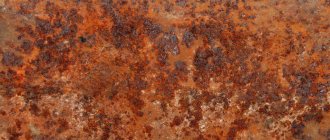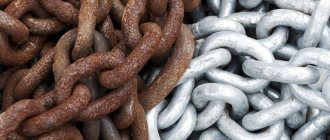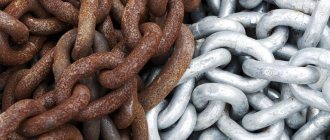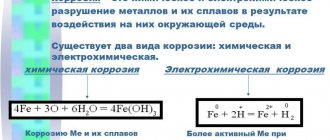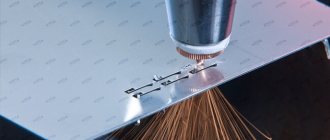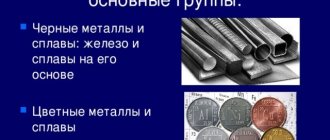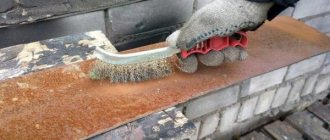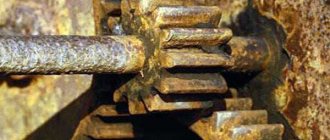Various European standards include more than 150 wrought aluminum alloys. However, only 17 of them are used in the construction of buildings according to Eurocode 9 [1]. An important condition for choosing these alloys is their level of corrosion resistance under various operating conditions of buildings with a minimum of maintenance. The following overview of the main types of aluminum corrosion provides an understanding of why some aluminum alloys can be used in construction and others cannot.
See more Construction aluminum alloys
Natural oxide coating
In most indoor and outdoor environments, aluminum is fairly resistant to corrosion and does not require additional protective coatings. This natural corrosion resistance of aluminum is provided by a thin but very effective oxide layer that spontaneously forms on its surface. This layer is impermeable and, unlike oxide films on many other metals, adheres very firmly to the base metal. If this oxide layer is mechanically damaged, it immediately repairs itself spontaneously.
This natural oxide coating is one of the main reasons for aluminum's outstanding corrosion properties. This coating is stable in the pH range from 4 to 9. In a strongly acidic or any alkaline environment, aluminum corrodes quite quickly.
Properties
Let's study the characteristics of aluminum. The described metal melts at a temperature of 659 degrees Celsius. The density of the substance is 2.69*103 kg/cm3. Aluminum belongs to the group of active metals. Resistance to corrosion processes depends on a number of factors:
- Purity of the alloy. For the production of various equipment, metal is taken that is distinguished by its purity. It should not contain various impurities. Aluminum grades AI1 and AB2 are widely used.
- Environment in which aluminum is located.
- What is the concentration of impurities in the environment surrounding aluminum.
- Temperature.
- The pH of the environment has a great influence. You need to know that aluminum oxide can form when the pH is in the range between 3 and 9. In an environment where an oxide film immediately appears on the surface of an aluminum sheet, corrosion processes will not develop.
Main types of corrosion of aluminum alloys
Structural aluminum alloys are characterized by the following most common types of corrosion [1-3]:
- general (uniform) corrosion;
- pitting corrosion;
- galvanic (contact) corrosion;
- crevice corrosion.
On painted aluminum products, such as powder-coated profiles, this may also occur.
- filiform corrosion [3, 4].
Types of corrosion such as:
- stress corrosion;
- intercrystalline corrosion;
- subsurface corrosion (exfoliation corrosion)
are more rare. They are typical for high-strength aluminum alloys of the 2000 and 7000 series, as well as alloys of the 5000 series with a high magnesium content, which are not recommended for use in construction [2-4].
Galvanic couples
The relative position of two metals or alloys in a galvanic series only indicates the possibility of galvanic corrosion if the difference in their galvanic potentials is large enough. This series says nothing more, and especially nothing about the speed or intensity of galvanic corrosion. It may be zero or insignificant or even unnoticeable. Its intensity depends on the types of metals that come into contact - the galvanic couple.
Pair: aluminum – non-alloy steel
In building structures, aluminum parts that are exposed to climatic and weather influences can be connected with screws made of ordinary steel. Experience shows that aluminum in contact with steel screws is subject to only very superficial corrosion. The resulting rust, which has no effect on the aluminum, completely saturates the aluminum oxide layer and forms stains on the surface. In fact, for an aluminum structure in contact with unprotected steel, its effect on appearance and decorative qualities will be more important than its ability to resist corrosion.
Main types of corrosion of construction aluminum
3.1. General corrosion
General corrosion, which is also called continuous corrosion [2], develops in the form of pits of very small diameter, on the order of one micrometer. As a result of this type of corrosion, a more or less equal decrease in thickness occurs over the entire surface of the aluminum product. For aluminum, this type of corrosion is characteristic of strongly acidic and alkaline conditions, in which the natural aluminum oxide film has a fairly high solubility.
Different aluminum alloys have different resistance to general corrosion. For example, the most common aluminum alloys in construction, such as 6060 and 6063 (AD31), which contain no more than 0.10% copper, have a fairly high resistance to general corrosion and are used in most operating conditions without any protective coating. However, aluminum alloys containing more than 0.5% copper generally have significantly lower corrosion resistance. Therefore, such alloys should not be used without protective coatings in environments with high chloride content, for example, near roads where salt is used to de-ice or near the sea coast [3].
3.2. Pitting corrosion
Pitting corrosion is often also called pitting corrosion. Pitting corrosion is a local form of corrosion, which is characterized by the formation of individual pits (ulcers) of irregular shape on the surface of aluminum. The diameter and depth of these pits depends on several factors, such as the chemical composition of the aluminum alloy, the type of corrosive environment and operating conditions.
3.2.1. The occurrence of pitting corrosion
Pitting occurs only in the presence of an electrolyte (water or moisture). Aluminum is prone to pitting in environments with a pH value of around 8. This includes virtually all natural environments such as fresh water, sea water and moist air.
Unlike other metals, pitting corrosion of aluminum is always clearly visible, since the corrosion pits are covered with white voluminous jelly-like “pimples” [3] of aluminum hydroxide Al(OH)3. These “pimples” are significantly larger than the corrosion pits they are located above. Figure 1 schematically shows the complex mechanism of pitting corrosion of aluminum.
Figure 1 — Mechanism of pitting corrosion of aluminum [4]
Pitting occurs when metal is in constant or frequent contact with an aqueous environment: water, seawater, rainwater and moist air. Experience shows that if pitting occurs, it always occurs within the first weeks.
It has long been known that pitting corrosion of aluminum develops in the presence of chlorides. Chloride ions penetrate the natural oxide film and tear it at weak points, forming microcracks [3].
3.2.2. Pitting rate
Most nucleated corrosion pits stop growing within a few days. Corrosion products accumulate above the corrosion pit and gradually block the entrance to it. This prevents the exchange of ions, especially chloride ions, which explains why pitting usually slows down and even stops.
In most cases, the depth of corrosion pits does not exceed 0.4 mm [4]. The depth of the corrosion pit increases approximately in proportion to the cubic root of time. This means, for example, that with an increase in the wall thickness of an aluminum pipe by a factor of two, its service life increases by 8 times [4].
That is why, according to Eurocode 9 (EN 1999-1-1), “thick” aluminum profiles made of alloys 6060 and 6063 with a thickness of 3 mm or more do not require corrosion protection up to the conditions of an industrial marine atmosphere.
See more details Protection of building aluminum from corrosion
3.2.3. Preventing and limiting pitting corrosion
To prevent or limit pitting corrosion, the correct choice of aluminum alloy and protective coating, usually powder or anodic oxide, is of great importance.
An important measure to prevent pitting corrosion is to design aluminum profiles and structures in such a way that they provide rapid moisture drainage and effective drying. In the absence of moisture, aluminum does not corrode.
3.3. Contact (galvanic) corrosion
3.3.1. Conditions for contact (galvanic) corrosion
Contact corrosion [2], which is more often called galvanic corrosion, occurs when two conditions are simultaneously met:
- there is contact between two different metals;
- there is an electrolytic “bridge” between these metals.
When assessing the risk of galvanic corrosion, all metals are ranked according to their degree of “nobility”. The less noble metal in contact becomes the anode and corrodes. The more noble metal becomes the cathode and is protected from corrosion. The only less noble metals than aluminum are zinc and cadmium. Therefore, in most combinations with other metals, aluminum is the less noble metal.
Galvanic corrosion is often the result of improperly designed structures. It does not occur in dry indoor air. There is no great risk of galvanic corrosion in rural areas. However, the risk of galvanic corrosion must always be taken into account in environments with high chloride content, such as coastal areas. Copper, carbon steel and even stainless steel can initiate galvanic corrosion under these conditions.
Problems can also arise when the metal combination is galvanized steel and aluminum. The zinc coating on galvanized steel will initially prevent the aluminum from corrosive attack. However, this protection ends when the steel surface is exposed after corrosion has eaten away all the zinc.
3.3.2. Prevention of galvanic corrosion
The risk of galvanic corrosion should not be exaggerated - this type of corrosion never occurs in dry interior environments and its risk in rural areas is minimal.
When different metals are used in contact with each other, galvanic corrosion can be avoided by electrically isolating them from each other. Figure 2 shows such a solution for a bolted connection.
Figure 2 - Prevention of galvanic corrosion in a bolted joint by electrical insulation [5]
In larger structures where such electrical isolation is difficult, other solutions are used to prevent electrical bridging between two dissimilar metals. An example of such a solution is painting surfaces with oil and enamel paints. Often it is more effective to paint the cathode surface, that is, the surface of a more noble metal.
3.4. Crevice corrosion
Crevice corrosion is local corrosion in various narrow recesses between materials (cracks) (Figure 3):
- rivet connections;
- bolted connections;
- welding joints;
- places where various deposits accumulate (sand, slag, dirt).
Figure 3 - Scheme of crevice corrosion [4]
When transporting and storing aluminum profiles packed in bundles, water sometimes collects in the cracks between the surfaces of adjacent profiles and causes surface corrosion, so-called “water spots.”
The source of this water is rain or condensation of moisture, which, due to the capillary mechanism, penetrates between metal surfaces. Condensation can occur when, for example, cold aluminum profiles enter a warm room.
Sometimes aluminum profiles are stored outdoors, for example, under a tarpaulin. In this case, the difference between day and night temperatures can also cause condensation on their surface.
3.5. Filiform corrosion
Filiform corrosion is characteristic of painted metal. It looks like narrow thread-like passages about 0.1-0.5 mm wide and several millimeters long between the paint layer and the metal base. Filiform corrosion always starts on paint defects such as scratches, cut edges or drilled holes. The damage caused by filamentous corrosion is purely decorative.
Powder coated alloy 6060 and 6063 window and door components may be subject to filament corrosion. To prevent this type of corrosion, the copper content in the aluminum alloy should not exceed 0.1% [4]. It is known that chemical etching of the surface layer of aluminum in an amount of at least 2 g/m2 before chromate surface preparation provides painted aluminum with high resistance to filamentous corrosion.
Friction rotary welding
Friction rotary welding is a solid state joining process that works by rotating one part relative to another while subjected to an axial compressive force. Friction between the surfaces produces heat, causing the interface material to plasticize. The compressive force displaces the plasticized material from the interface, promoting metallurgical bonding mechanisms. Without entering a liquid state, friction welds remain much cooler during processing.
In addition, welding aluminum, fast friction, preventing the weld from being exposed to high temperatures for a long time. Consequently, friction welding is used commercially to join a range of dissimilar materials as the formation of intermetallic compounds is greatly reduced.
Despite the advantages of friction welding in reducing intermetallic formation between aluminum alloys and steels, care must still be taken in the selection of parameters.
Other types of corrosion
4.1. Stress Corrosion
Stress corrosion, which leads to cracking, is a rarer type of corrosion. This type of corrosion occurs primarily in high-strength alloys such as 2000 series (AlCu) and 7000 series (AlZn) and 5000 series (AlMg) alloys with magnesium contents greater than 4%. This occurs when a metal is subjected to prolonged tensile stress in the presence of a corrosive environment. This type of corrosion does not typically occur in the 6000 series AlMgSi aluminum alloys, including the popular 6060 and 6063 alloys [1].
4.2. Intergranular corrosion
Intergranular corrosion affects the boundaries of metal grains, and not the grains themselves. 6000 series alloys, such as 6060 and 6063, are generally resistant to intergranular corrosion. The formation of a recrystallized structure (with a large grain size) in profiles, as well as a high content of silicon and copper, can contribute to this type of corrosion. To prevent or minimize recrystallization, manganese and chromium are added to aluminum alloys.
Intergranular corrosion is especially characteristic of the 7000 series alloys. Here it is associated with MgZn precipitates, which are very anodic compared to aluminum and therefore corrode [4].
4.3. Subsurface corrosion
Subsurface corrosion is a type of selective corrosion that extends below the surface of the metal along one or more planes. This type of corrosion occurs mainly in rolled products made from high-strength alloys of the 2000, 5000 and 7000 series.
Battery principle
Galvanic corrosion works like a battery, which consists of two electrodes:
- cathode where the reduction reaction occurs
- anode where the oxidation reaction occurs.
These two electrodes are immersed in a conductive liquid called an electrolyte. An electrolyte is usually a dilute acid solution, such as sulfuric acid, or a saline solution, such as copper sulfate. These two electrodes are connected externally by an electrical circuit that allows electrons to circulate. Inside a liquid, electric current is transmitted by the movement of ions. The liquid thus provides an ionic electrical connection (Figure 9).
Corrosion of aluminum in various environments
5.1. Aluminum outdoor
Corrosion of metals in the open air depends on the time during which the metal surface is wet and the chemical composition of the electrolyte on its surface. Surface wetness duration is the period of time during which the surface is wet enough for corrosion to occur. This usually occurs at relative humidity above 80% and at the same time at temperatures above zero.
In a normal rural atmosphere and in an atmosphere with an average sulfate content, aluminum in its natural state has a fairly high corrosion resistance.
In atmospheres with high sulfate content, minor pitting may occur. However, under these conditions, aluminum's corrosion resistance is significantly higher than that of carbon steel or galvanized steel.
The presence of salts (especially chlorides) in the ambient air reduces the resistance of aluminum to corrosion, but to a lesser extent than that of other structural materials [3].
5.2. Aluminum in soil
Soil is not a homogeneous material. Mineral chemistry, moisture content, pH value, presence of organic materials and electrical conductivity can vary widely from place to place. These differences make predictions about the corrosion resistance of metals in soil difficult. In addition, other factors, such as stray currents, can affect the corrosion resistance of metals in the soil.
When using aluminum in soil, special protective coatings are used, for example, bitumen.
5.3. Aluminum in water
Corrosion of metals in water depends on the chemical composition of the water. The corrosion resistance of aluminum in water is most influenced by the presence of chlorides and heavy metals in water.
In natural fresh water and drinking water, aluminum can be subject to pitting corrosion. However, with regular drying and cleaning, the risk of corrosion damage under these conditions is minimal. In recent times, household aluminum pots, pans and other kitchen utensils have been used for decades without any signs of corrosion.
In seawater, alloys of the 5000 series (AlMg) with a magnesium content of over 2.5%, as well as, to a lesser extent, alloys of the 6000 series (AlMgSi) exhibit particularly high corrosion resistance.
Aluminum alloys with a high copper content, for example, the well-known “duralumin”, are usually not used for working conditions in water. When performance of these alloys under such conditions is unavoidable, they must be provided with reliable corrosion protection, such as full-length painting.
5.4. Aluminum and alkaline building materials
Splashes of wet alkaline building materials, such as mortar or concrete, leave superficial but fairly visible stains on the surface of aluminum. Because these stains are nearly impossible to remove, visible aluminum surfaces must be protected during construction site work.
Aluminum that is poured into concrete will react in a similar way. This increases adhesion between materials. When the concrete “sets,” the corrosive effect of concrete on aluminum usually stops. However, if moisture gets between the aluminum and concrete, corrosion will continue. An increase in the volume of corrosion products can cause cracks in concrete.
This type of corrosion can be effectively prevented by coating the aluminum with a bitumen coating or paint that can withstand alkaline environments. Since the oxide layer is unstable in highly alkaline conditions, anodizing aluminum will not help here.
In dry interior conditions, once the concrete has fully set, aluminum no longer requires any corrosion protection.
5.5. Aluminum and chemicals
Due to the protective properties of the natural oxide layer, aluminum shows good resistance to many chemicals. However, low or high pH values (less than 4 and greater than 9) lead to the dissolution of the oxide film and, consequently, rapid corrosion of aluminum. Therefore, inorganic acids and concentrated alkaline solutions are very corrosive to aluminum.
Exceptions are concentrated nitric acid and ammonia solutions. They practically do not react with aluminum.
In moderate alkaline aqueous solutions, corrosion can be avoided by using silicates as inhibitors. These types of inhibitors are usually found in dishwashing detergents.
Most inorganic salts are not particularly corrosive to aluminum. The exceptions here are salts of heavy metals.
Aluminum has very good resistance to most organic compounds. Aluminum equipment is used in the production and storage of many organic substances.
Methods for removing carbon deposits
Layered carbon deposits on the outside of the frying pan or food residues on the bottom that have burned and firmly stuck to the metal surface cannot be removed using the methods described above. Let's look at powerful cleaning methods.
Option 1. Soda + glue. Pots or pans made of aluminum, on the walls of which carbon deposits have formed, are soaked for 3-4 hours in a solution made from baking soda, office glue and water.
Ten liters of hot water are poured into a container of suitable size, then one hundred grams of soda and silicate glue are dissolved in it. Utensils soaked in a cooled solution are cleaned with a sponge until shiny and thoroughly rinsed in clean water.
Option 2. Table vinegar. If you do not have special tools at your disposal that can effectively clean a burnt aluminum pan, use regular table or apple cider vinegar (6 or 9%), you can also dilute the essence in a ratio of 1 part to 10 parts water.
Vinegar should be poured into a frying pan or pan with burnt food at the bottom. Place the dishes on the stove and turn on high heat. Bring the liquid to a boil, remove the frying pan or saucepan from the heat and let it cool completely.
When the temperature of the liquid reaches room temperature, use a sponge to wash off the remains of burnt food. Then the dishes are washed well under running water.
Vinegar can also be used to clean aluminum utensils from dark stains and oxide. It is enough to moisten a rag with the composition and carefully treat the aluminum surfaces.
When using vinegar, be sure to protect your hands with rubber gloves. If you choose the boiling option, open the window for ventilation and turn on the hood to prevent the pungent odor from spreading throughout the apartment.

